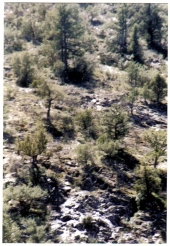posted 14 years ago
I dont know about peach tree roots, and i have just looked it up but it seems to be a big job to find out a lot about them one place talks of five foot deep, but what you say has made me think of these things to say about roots.
I read recently that the quince, tree that is often used as a root stock for pear trees, has shallow roots,while the pear has deep roots, so i doubt that the roots of a tree wil be shallow because it has a root stock, i imagine that whether its roots are shallow or deep depend on whether the root stock used has shallow or deep roots. The perry pears i want to buy are grafted on pyrus communis and so have deep roots sccording to the nursery but the other pears i want to but are grafted on to a quince so they will have shallow roots.
As i said at the begining of this thread, the quince seems to manage the summer droughts easily so having a shallow root does not make a plant less likely to manage drought. Heidi Guildmeister who has a very good book on how to garden with little watering, says that many mediteranean trees have shallow rooots these collect the water of an occasional thunder storm, maybe they collect dew too.
Also, i was going through Brad Lancasters videos, I don't remember why, to listen again about the small basins which will hold water and stop it running off so as to have damp spots for his plants maybe and somwhere he says that velvet mesquite has deep roots and chilean mespuite shallow ones, which struck me because maybe some members of a family of trees will have shallow roots and other members of the same family deep roots. I imagined that if one type of juniper say had deep roots another one would too but it seems that you can't bet on that being the case.
Another point is that trees grown in situ, from seed, has a chance when the seed grows to put their tap root down into the soil and that is what grows most at first, so the tree grown from seed, where you mean it to live, will soon have a long tap root, longer than that of maybe an older plant bought in a pot and planted in the ground whose tap root has not been allowed to grow straight down or than a bare root bought tree whose tap root may have been cut off, so at first the plant grown from seed has the advantage of a long root that has dug way down into the soil that the others dont have but plants do grow new down growing roots later in life called sinker roots so in the end the pot plant or the bare root plant you have grown wil have roots that go down just as deep as the one grown from seed.
Another thing that maybe you have to consider is do the trees have plenty of water or not, in an orchard they maybe have so much water that they dont put down tap roots, i dont know if this is a factor but maybe it is. rose macaskie.







































































